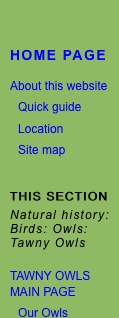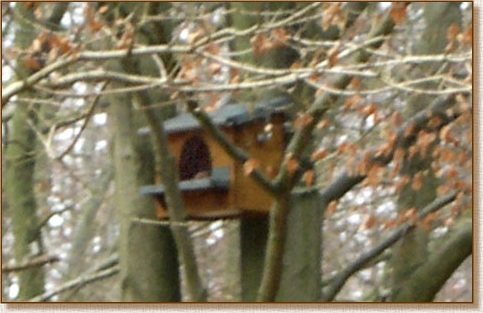 | |||||||||||||||||||||||||||
 | |||||||||||||||||||||||||||
The nestbox in late December 2005. It's already been up in its beech tree for a year, but there's still several months to go before the local female decides to use it in preference to the crows' nests in the pines behind. | |||||||||||||||||||||||||||
 | |||||||||||||||||||||||||||
17 March 2006 -- First nestbox inspection WE'RE DOWN IN KENT for the weekend. The weather is cold, overcast, hovering a couple of degrees above zero as it has done for much of the past four months. On the basis of limited data from the British Trust for Ornithology on Tawny Owl nesting times I've settled on mid-March as the time we need to start regular inspections of the nesting area. On the other hand I'm preparing to stave off disappointment by recalling a report that Barn Owls nest late after a cold winter when food is scarce as they need to feed up before starting a family. Sounds common sense, so maybe it's what the tawnies do too. It's so chilly that if I were a vole I think I'd be staying in my burrow! We make a routine inspection of the crows' nests in the Scots Pines, and continue on to the nestbox suspended 15 feet up its beech. I am expecting nothing, and there is nothing. No sign that owls have been around. No pellets, no poo, nothing. The only thing that keeps me hoping is a tawny primary feather I found beneath the nestbox last summer. It is large and pale (I still have it) and I feel sure it belongs to the mother as she is a big bird and distinctively pale. Her wingspan is so large that she looks like an eagle when she sails through the pines, making one wonder why such large birds have taken up living in woodland. Well, one says large: in fact they are quite diminutive birds with very large, bulky wings. Their bodies are remarkably small -- little more than a small pod to hold food. You can cup a tawny's body in one hand. At the top is a disproportionately large looking head -- in fact it is half fluff -- and at the other end a pair of very long, strong legs with powerful toes and sharp claws. They are weirdly constructed birds. | |||||||||||||||||||||||||||
The path to the owls. The two pics show the ride after a snowfall on 28 December 2005. By lunchtime the sun was out and scenes like this were fast disappearing. In the second photo the Scots Pines used by this pair in previous years start in the middle of the pic and continue on down the left of the ride. | |||||||||||||||||||||||||||
24 March -- second visit BACK DOWN IN KENT. The weather's improving, the sun is out, the temperature's going up by the day, the birds are beginning to sing. It feels as if spring has arrived. Today is complicated because my mother had an accident four days ago and is scheduled to be transferred from hospital to a care home some six miles away. I'm supposed to be visiting her, but we don't know when she's turning up and I've little idea where the home is except that it's in the village where the man lives who recently masterminded a £42 million robbery of used bank notes, quite a few of which he buried in his garden. Locals who know him say they can't imagine why he did it as he was perfectly well off before. But he was a car dealer, so there you go. In mid-morning, fortified by a stiff coffee and toast, I set off to inspect the nesting area. Corinne didn't come as she was busy on her computer. The woods start immediately behind the house. First there's an area of oaks that belongs to Corinne's mum, and then you come out into a much larger area of managed mixed woodland that belongs to some people in London. This is divided up by rectilinear paths, or rides, and I set off west down one of them (see top photo above) to get to where the owls are. It's only 500 yards or so, and in the sun the walk was pleasant. This time I have my binoculars. After a curve in the path and a left turn where two rides cross, one arrives at a small triangular stand of Scots Pines (middle photo above). This is where the two tawnies we feel we know so well choose to nest. Their territory extends off to the north and west, beyond the wood and into a farmer's fields. The farmer has seen them on the roofs of his buildings. It seems that most of the year, and to do their hunting, they stay on the farmland, but in the spring they come up into this wooded corner of their territory to breed. A public footpath runs along one edge of the pines, but it's hardly used and the area is quiet and secluded. On the other side of the path are several acres of magnificent oak woodland. Beyond that are more fields in which sheep are kept, then a tiny lane, and across that the impressively large expanse of Hemsted Forest. It's a good area for tawnies. Making my way quietly along the path I carefully examine the half dozen or so crows' nests in the pines. They're all about 35 feet up, near the crowns, and by now looking distinctly tatty. Crows can't have used them in years. These small, disintegrating platforms of weathered twigs are what the two owl parents have been trying to raise a family on for at least three years now -- the three years we have known them. This is the fourth season. The result has been six chicks out of six lost (assuming two chicks in each brood). Two we've managed to save, and the other four have died. I am dreading seeing her on one of these nests again. As far as I could see she wasn't on a nest. So I walked on to the end of the pine stand, to where another large area of oaks begins on the same side as the pines. Between the pines and the oaks, and about 50 yards back from the footpath, is the beech, which must have sowed itself as it is not part of the scheme of things. Not unlike the nestbox fastened to it. This time I thought it best not to approach in case she was in the box, and if she was I didn't want to make her feel nervous. | |||||||||||||||||||||||||||
"If the shape moves it's an owl . . " I walked on down the path until I came to a gap in the trees I could peer through with the binos. I was now 70-80 yards from the nestbox -- good from the point of view of angle but something of a long shot. Peering into the distant box with 10x binos I immediately saw a shape, a sort of long hump just showing over the base of the entrance door. Something in me jumped. It was only the top of a shape, but it was too smooth and solid to be a spray of beech leaves brought in by a squirrel, and it was a brownish colour, though the poor light, the distance and the wobbling of the binos meant it was impossible to be sure. | |||||||||||||||||||||||||||
The nestbox goes up in November 2004. The mother owl gave it a miss the following spring. | |||||||||||||||||||||||||||
Further down the path, maybe almost 100 yards from the nestbox now, another smaller and slightly higher roundish shape became visible. I thought about it, then fished out my mobile to phone Corinne at her computer. "I think there may be an owl in the nestbox", I say, "but I'm not at all sure." "In the nestbox?!" "Yes, but I'm miles away and it's difficult to make out anything. I can't see any features, just a shape which might be the top of her back, and another lump which might be a head. I just don't know. It's not even worth coming out. Let's have another look later. If the shape's moved, it's an owl."
Later that morning A couple of hours later we went out to have another look. About 200 yards from the nestbox my phone rang, loudly, shattering the quiet of the woodland with its jangly tune. It was my sister with news that our mother would be arriving at the care home at three that afternoon. I promised to be there and told her that we were in the woods, within hearing range of the nestbox, where we thought Sophie and Owly's mother might be. She is terribly smitten by Sophie. Nearer the nestbox we got good views. The sun had moved round and the light was better. More important, the shape had moved and we both saw, quite clearly, the distinct markings on the owl's head. She was looking at us, but keeping low, trying to hide. It actually made her look rather sheepish, if an owl can look sheepish. The mark that distinguishes her is the V of pale-coloured feathers seen on many tawnies' heads, but in her case the V is large and prominent and the feathers are brilliant white. Now there was no room for doubt -- we were looking at the mother owl and she was almost certainly sitting on eggs. Best of all, she had at last chosen to use the nestbox. I felt an adventure was about to begin. | |||||||||||||||||||||||||||
 | |||||||||||||||||||||||||||
My Nikon Coolpix 4300 simply cannot focus properly in the woods, but all the same here is a telephoto taken from some distance of Mrs Owl in her nestbox. The top of her head is just visible -- she's looking out towards the left. That's pretty much all we saw the first time we found her. Photo taken the next day (25 March). | |||||||||||||||||||||||||||
 | |||||||||||||||||||||||||||
powered by owls | |||||||||||||||||||||||||||
Mid-March 2006
The Diary starts . . .